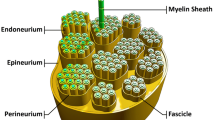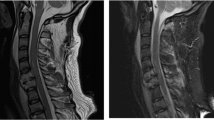Abstract
Objective
Long thoracic nerve (LTN) injury can result in ipsilateral serratus anterior palsy and scapular winging. Traditional means of evaluating patients with suspected LTN injury include physical examination and electrodiagnostic studies. The purpose of our study is to describe high-resolution magnetic resonance (MR) findings in patients with clinical suspicion of LTN neuropathy.
Methods
In this HIPAA-compliant, IRB-approved, retrospective study, two radiologists reviewed MR imaging performed for long thoracic neuropathy. Clinical presentation, electrodiagnostic studies and MR imaging of 20 subjects [mean age 37 ± 13 years; 25% (5/20) female] were reviewed. Observers reviewed MR imaging for LTN signal intensity, size, course, presence or absence of mass and secondary findings [skeletal muscle denervation (serratus anterior, trapezius, rhomboid) and scapular winging]. Descriptive statistics were reported.
Results
Clinical indications included trauma (n = 5), hereditary neuropathy (n = 1), pain (n = 8), winged scapula (n = 6), brachial plexitis (n = 4) and mass (n = 1). Electrodiagnostic testing (n = 7) was positive for serratus anterior denervation in three subjects. Abnormal LTN signal intensity, size, course or mass was present in 0/20. Secondary findings included skeletal muscle denervation in the serratus anterior in 40% (8/20), trapezius in 20% (4/20) and rhomboid in 20% (4/20). In 5% (1/20), an osteochondroma simulated a winged scapula, and in 2/20 (10%) MR showed scapular winging.
Conclusions
High-resolution MR imaging is limited in its ability to visualize the long thoracic nerve directly, but does reveal secondary signs that can confirm a clinical suspicion of LTN injury.






Similar content being viewed by others
References
Chhabra A, Thawait GK, Soldatos T, et al. High resolution 3T MR neurography of the brachial plexus and its branches with emphasis on 3D imaging. AJNR. 2013;34:486–97.
Nguyen C, Guerini H, Zauderer J, et al. Magnetic resonance imaging of dynamic scapular winging secondary to a lesion of the long thoracic nerve. Joint Bone Spine. 2016;83(6):747–9.
Lieba-Samal D, Morgenbesser J, Moritz T, et al. Visualization of the long thoracic nerve using high-resolution sonography. Ultraschall Med. 2015;36(3):264–9.
Bertelli JA, Ghizoni MF. Long thoracic nerve: anatomy and functional assessment. J Bone Joint Surg Inc. 2005;87(5):993–8.
Safran MR. Nerve injury about the shoulder in athletes, part 2. Am J Sports Med. 2004;32(4):1063–76.
Kaplan PE. Electrodiagnostic confirmation of long thoracic nerve palsy. J Neurol Neurosurg Psychiatry. 1980;43(1):50–2.
Wang JF, Dang RS, Wang D, et al. Observation and measurements of long thoracic nerve: a cadaver study and clinical consideration. Surg Radiol Anat. 2008;30:569–73.
Aquino SL, Duncan GR, Hayman LA. Nerves of the thorax: atlas of normal and pathologic findings. Radiographics. 2001;21:1275–81.
Gregg JR, Lavosky D, Harty M, et al. Serratus anterior paralysis in the young athlete. J Bone Joint Surg Am. 1979;61:825–32.
Foo CL, Swann M. Isolated paralysis of the serratus anterior. A report of 20 cases. J Bone Joint Surg Br. 1983;65:552–6.
Martinoli C, Gandolfo N, Perez MM, et al. Brachial plexus and nerves about the shoulder. Semin Musculoskelet Radiol. 2010;14(5):523–46.
Park HJ, Kim SS, Han CH, et al. The clinical correlation of a new practical MRI method for grading cervical neural foraminal stenosis based on oblique sagittal images. AJR Am J Roentgenol. 2014;203(2):412–7.
Baumer P, Kele H, Kretschmer T, et al. Thoracic outlet syndrome in 3T MR neurography-fibrous bands causing discernible lesions of the lower brachial plexus. Eur Radiol. 2014;24(3):756–61.
Demondion X, Herbinet P, Van Sint JS, et al. Imaging assessment of thoracic outlet syndrome. Radiographics. 2006;26(6):1735–50.
Kikuchi Y, Nakamura T, Takayama S, Horiuchi Y, Toyama Y. MR imaging in the diagnosis of denervated and reinnervated skeletal muscles: experimental study in rats. Radiology. 2003;229:861–7.
Polak JF, Jolesz FA, Adams DF. Magnetic resonance imaging of skeletal muscle. Prolongation of T1 and T2 subsequent to denervation. Investig Radiol. 1988;23:365–9.
Kim SJ, Hong SH, Jun WS, et al. MR imaging mapping of skeletal muscle denervation in entrapment and compressive neuropathies. Radiographics. 2011;31:319–32.
Martin RM, Fish DE. Scapular winging: anatomical review, diagnosis, and treatments. Curr Rev Musculoskelet Med. 2008;1:1–11.
Johnson JT, Kendall HO. Isolated paralysis of the serratus anterior muscle. J Bone Joint Surg Am. 1955;37-A:567–74.
Friedenberg SM, Zimprich T, Harper CM. The natural history of long thoracic and spinal accessory neuropathies. Muscle Nerve. 2002;25(4):535–9.
Kassardjian CD, O’gorman CM, Sorenson EJ. The risk of iatrogenic pneumothorax after electromyography. Muscle Nerve. 2016;53(4):518–21.
Bendszus M, Wessig C, Reiners K, et al. MR imaging in the differential diagnosis of neurogenic foot drop. AJNR Am J Neuroradiol. 2003;24(7):1283–9.
Author information
Authors and Affiliations
Corresponding author
Ethics declarations
Conflicts of interest
The authors declare that they have no conflicts of interest.
Grant support
No relevant support.
Rights and permissions
About this article
Cite this article
Deshmukh, S., Fayad, L.M. & Ahlawat, S. MR neurography (MRN) of the long thoracic nerve: retrospective review of clinical findings and imaging results at our institution over 4 years. Skeletal Radiol 46, 1531–1540 (2017). https://doi.org/10.1007/s00256-017-2737-z
Received:
Revised:
Accepted:
Published:
Issue Date:
DOI: https://doi.org/10.1007/s00256-017-2737-z




